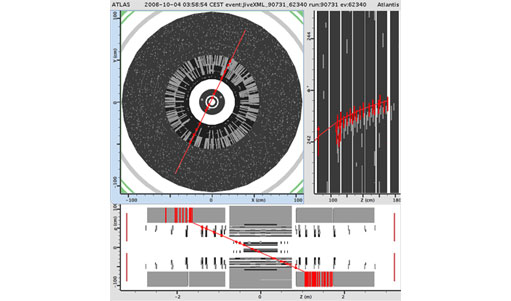
ATLAS e-News
23 February 2011
L2 Cosmic trigger
3 Novembe r 2008

A cosmic event in the inner detector
Just before opening the detector, a big step towards the final commissioning of the inner detector (ID) occurred; for the first time, the three sub-systems of the ID simultaneously read cosmic rays.
Thanks to the join efforts of the trigger and the ID groups on ATLAS, the Pixel detector, the Silicon Tracker (SCT) and the Transition Radiator Tracker (TRT) saw cosmic events coming through. “It was the first time that we could read cosmic tracks in the pixel detector,” says Cristóbal Padilla, ATLAS trigger operations coordinator.
“Using the new data, the ID team has been able to do further alignment and efficiency studies. And, as they improved the alignments constants, we also improved the efficiency of the tracking,” he adds.
In the weeks between the sudden halt of the LHC and mid-October, the ATLAS trigger team modified the algorithms that run at the core of the ATLAS Level 2 trigger software. “We triggered on events that have detected a region of interest at the ATLAS Level 1 trigger and with this information we reconstructed tracks in the inner detector at Level 2,” Cristóbal explains.
“Because the rate of cosmic rays is very high, we built a system to select events coming only through the inner detector volume.”
The cosmic tracks in the ID can be useful to other ATLAS collaborators to do efficiency and alignment studies in their own sub-systems. So, the ATLAS trigger group stored all the relevant events in a special file known as ID Cosmics stream.
“We used the existing software of the Level 2 trigger but adapted it to processing data coming from cosmic rays rather than that of collisions,” says Cristóbal.
“Also, we have improved the fraction of off-line tracks in the ID that we redirect to the IDCosmic stream. Before it used to be about 70%, and now we select all of them.”
The enhancement of the inner detector data-taking systems also brought a further development of the ATLAS Level 2 trigger software. The trigger system works by recognising and selecting different type of fundamental particles. The selection algorithms change depending whether those particles come from the centre of the detector, as in the case of particles coming out of collisions, or from above, when the data arrive from cosmic rays.
So, while working on creating the ID cosmics stream, the trigger group had to adapt the Level 2 algorithms and trigger menus, which had been designed to cope with data coming from collisions, and make it ready to take on data coming from cosmic rays.
“I consider it a success that in such a short period of time, we have been able to integrate the old cosmic selection software, used in previous Milestones runs, to the system we made ready for September 10th,” says Cristóbal.
Before, the system could only work in one of the modes at a time, either taking data from collisions or from cosmics. Now, the software can work simultaneously analysing data coming from cosmic rays and from collisions.
“Even if the LHC is working, at the very start of a run, there are no collisions, so the option of running the software just for cosmic data and then gradually going into collision-data taking mode was needed,” Cristóbal explains.
“Before, we had to stop the run to switch between one mode and the other, and re-start it again; this can be a very lengthy process, taking from 30 minutes to three hours or more,” he adds.
With the detector open, the cosmic data taking is over, but the work of improving the trigger system continues. “We can use collision data generated in Monte Carlo simulations or feed the software with data previously taken; also we can test certain errors coming from different sub-systems. There are lots of work we can do offline!” says Cristóbal.

Cristina JimenezATLAS e-News |